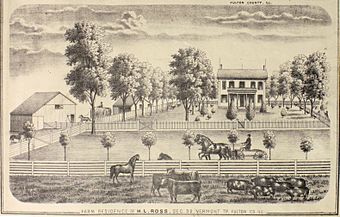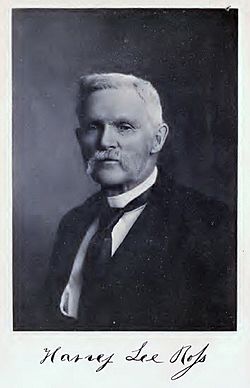Harvey Lee Ross House facts for kids
Quick facts for kids |
|
|
Harvey Lee Ross House
|
|

Drawing of the farm and residence of Harvey Lee Ross, published in 1871. The barn and summer kitchen, shown to southeast of the house in the drawing, are actually to the southwest.
|
|
| Location | 602 S. Main Street, Vermont, Illinois |
|---|---|
| Built | c. 1858 |
| Architectural style | Greek revival, with Italianate elements |
| NRHP reference No. | 96001295 |
| Added to NRHP | November 7, 1996 |
The Harvey Lee Ross House is a two-story house built around 1858. It stands on what was once the farm of Harvey Lee Ross near Vermont, Illinois. This house and its other buildings were added to the National Register of Historic Places (NRHP) in 1996. They are special because of their unique architecture and their connection to Harvey Lee Ross. The house shows off a style called Greek Revival, with some Italianate details. Harvey Lee Ross, the first owner, was a railroad builder, banker, merchant, and farmer.
History of the Ross House
The Harvey Lee Ross house, along with its summer kitchen and barn, was built around 1858. The Ross family lived here until 1873, when they moved to Macomb, Illinois. After them, Aaron A. Bellangee bought the property. He lived there with his family until the early 1910s.
Later, the Bellangee's daughter, Rebecca, and her husband, Marshall Freeman, owned the house. They lived there from the early 1910s until 1927. From 1927 to the 1940s, Mr. and Mrs. Charles E. McCormick owned the property. Then, Mr. and Mrs. Otto Ward, who were retired farmers, bought it. When the house was listed on the National Register of Historic Places, it belonged to Ralph Malott, his daughter Nelda, and her husband, James C. Fell.
After 1873, some parts were added to the house. New buildings were also put up. These included a kitchen, a bathroom, and different storage areas. The inside of the house also changed. For example, the first-floor pine floors were replaced with oak. Some wooden doors were changed to French doors. Most of these updates happened in the 1880s and early 1900s.
What Does the House Look Like?
The Harvey Lee Ross House has two stories and is made of wood. It has a common layout called "four-over-four." On the first floor, there is a central hallway. Two rooms are to the south, and a large living room is to the north. The second floor also has a central hall with two rooms on each side.
The house's main style is Greek Revival. This means it has a one-story front porch with four Doric-style wooden columns. These columns have special grooves called fluting. The house also has six-over-six windows. The front door has a divided window above it called a transom. Above the porch, there is a fancy cast-iron railing. Inside, you can see more Greek Revival details. The wood around the windows and doors has fluting. The main living room has special windows and transoms.
The house also has some Italianate touches. For example, there are small, pretty brackets above the front entryway.
Other buildings on the property are also part of its historic listing. These include a one-story summer kitchen, a large barn, a shed/garage, a storage shed, a machine shed, a chicken coop, and an outhouse. The summer kitchen and barn were built around the same time as the house. They were made using old building methods like mortise and tenon joints. The other buildings were added later.
Meet Harvey Lee Ross
Harvey Lee Ross was the first owner of this farm. He was born in Seneca County, New York, on October 10, 1817. When he was four years old, in 1821, his family moved to Fulton County, Illinois. They settled in the area that became Lewistown. His father founded this town and named it after Harvey's older brother, Lewis.
Harvey Ross had a short education in local log schoolhouses. At age 15, he became a mail carrier. He delivered mail along a long route from Springfield to Monmouth, Illinois. One of the post offices on his route was in New Salem, Illinois. Guess who was the postmaster there? None other than Abraham Lincoln!
In 1836, Ross went to Illinois College in Jacksonville, Illinois. His friend there was William H. Herndon. Herndon later became a law partner with Abraham Lincoln. Harvey Ross left college in 1837 when his father passed away. He went to Havana, Illinois, to manage his father's businesses. This included running the Havana Hotel and overseeing the ferry across the Illinois River. He also became the postmaster in Havana, appointed by President Martin Van Buren.
Harvey Ross married Jane R. Kirkpatrick on January 1, 1840. They had six children together.
In 1844, the Ross family moved to land near Vermont, Illinois. Here, Harvey Ross became a farmer and raised animals. He also worked in local trade. He ran a grocery store in Vermont's town square. He bought and shipped grain and ran a pork packing plant. In 1859, he opened Fulton County's first bank, called the Fulton Bank, in Vermont.
In the 1860s, Ross was a big supporter of building a railroad line through Vermont. He gave money and land for the railroad to pass through his property. He also donated land for a train station. He was even on the board of directors for the Macomb, Vermont, and Bath Railroad Company.
In 1873, Ross moved to Macomb, Illinois. He continued farming there until 1882. Then, he moved to Oakland, California. In Oakland, he worked as a real estate dealer and farmer. When he moved west, he owned many farms in Illinois. Harvey Lee Ross lived in Oakland until he passed away on January 27, 1907. He was buried in Mountain View Cemetery in Oakland, where his wife Jane had been buried earlier.
When he was in California, Harvey Lee Ross was asked to write about his memories of early life in Illinois. He wrote these stories when he was in his 80s. They were first published in a newspaper called the Fulton Democrat. Later, they were put into a book. The book includes his personal memories of Abraham Lincoln, Andrew Jackson, and Peter Cartwright. It also tells his own life story. This book has been very interesting to people who study Abraham Lincoln.
Some people have wondered if Harvey Lee Ross was the inspiration for a character named Thomas Ross, Jr., in Edgar Lee Masters' famous book, Spoon River Anthology. However, it's not certain. The poem suggests Thomas Ross, Jr., was hurt by his brother's ambition. This doesn't seem to match Harvey Lee Ross's life.
As for myself I overcame my lower nature
Only to be destroyed by my brother's ambition.




